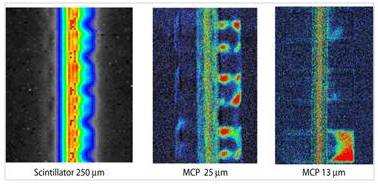| * |
|
Evolution of Image Spatial Resolution
Summary:Measuring the through-plane water content in a hydrogen fuel cell is critical to understanding this complicated heat and mass transport environment, where the waste heat produces temperature gradients, the inlet and outlet gases are a two phase flow phenomenon, and the porous media has a wide range of both pore diameters and wettabilities. Description:Neutron imaging has yielded valuable insight into the water content of fuel cells, since minimal changes to a test section are needed. A limit of neutron imaging is the achievable spatial resolution, which is primarily dominated by the detector. This effect is clearly demonstrated in, where the water content in a fuel cell was measured by three separate detectors at nominally the same operating conditions. With the new "10 micron" detector, researchers using the NIST neutron imaging facility are able to directly measure the water content and distribution in the porous media with unprecedented details that have been never achieved before. The approach at NIST is to define critical technical parameters of detectors, collaborate scientifically, and provide support to academic and industrial partners in the development of such detectors. This collaborative effort resulted in the development of high resolution detectors based on Micro-Channel Plates (MCPs) with sub-ten micrometer channel diameters and readout electronics capable of neutron count rates of greater than1 MHz; this represents a 20-fold improvement in the spatial resolution and factor of 1000 increase in neutron count rate over 4 years and is the current state-of-the-art in neutron detection. While the range of the charged particles in the MCPs limits the current resolution of this technology to about 10 μm, there is still development work in progress to increase the field of view for wider use of the enhanced imaging capability. Since there is a very significant interest in the studies of water transport, content, and mapping in catalysts layers and membranes, there is also ongoing exploration of other means to further improve the spatial resolution of neutron imaging. |
 Progression of improved spatial resolution in the measured through plane direction of a hydrogen fuel cell Lead Organizational Unit:pml |
